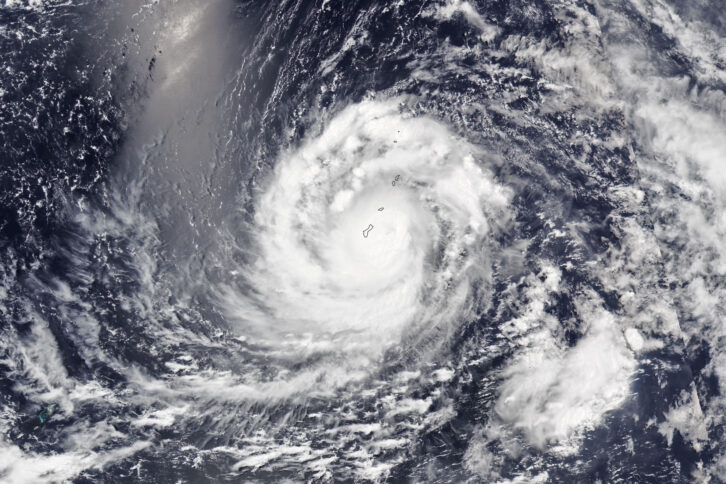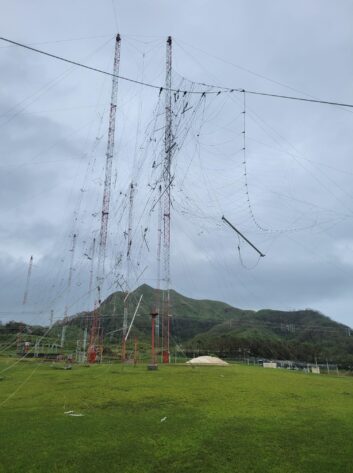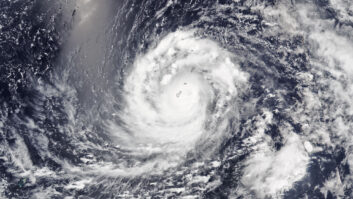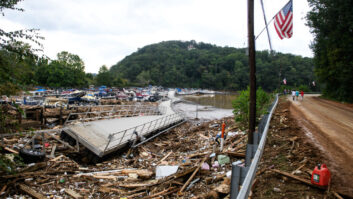
In the U.S. Pacific territories of Guam and the Northern Marianas Islands, the damage done by Super Typhoon Mawar is being assessed. While contact with Guam is limited, media reports from the island indicate there are widespread power outages, along with some coastal flooding.
On its Facebook page, Choice Broadcasting’s KUSG(FM), The Point, wrote: “We have fallen victim to the worst storm this century. We’ve got our work cut out to restore our studios and transmitter site. We are anxious to return to the air and hope it’s not too long.”
[Update: “Guam Media Meets with Governor’s Office”]
NPR affiliate KPRG(FM)’s website said the station “will be off the air for the foreseeable future in Guam as we evaluate the damage at our tower location from typhoon Mawar. While on the air in Saipan, we have to shut the studios down due to running out of generator fuel. Once our fuel is replenished we will resume operations.” The KPRG transmitter in Saipan, the capital of the Northern Mariana Islands, relays programming from the KPRG studios at the University of Guam in Mangilao.
Christian station KHMG(FM), Harvest Family Radio, similarly noted on Facebook that both its studios and transmitter were operating on generator power.
Trans World Radio reported on Facebook from its staff on Guam that the TWR “broadcasting facility escaped severe damage.” The missionary group’s shortwave facility, KTWR, is used to broadcast programming into Asia. According to a post at the World Radio –Television Handbook Facebook group, KTWR recorded a wind gust of 108 mph at the weather station on one of its towers.

TWR posted an update to Facebook around 6 a.m. Chamorro Standard Time (UTC +10) on May 26. “Grant Hodgins, station director at KTWR, and two key members of the team were able to reach the station on Thursday morning. Although it was still too windy for a close inspection, it was apparent that all five of our antennas sustained damage.” The post said that the station’s Antenna 1 was a total loss.
Television station KUAM, which is co-owned with KAUM(FM), The Breeze 93.9, reported that its studios suffered “extensive damage … that has impacted our full scale of operation.”
Speaking on KUAM-TV on the morning of May 26, Krystal Paco-San Agustin, communications director for Gov. Lou Leon Guerrero, highlighted efforts to restore power across the island with a focus on critical infrastructure — hospitals, wells, wastewater facilities, and telecommunications. “We’re going to get our radio stations back online … yesterday, we were in the dark a bit, you know, with no radio communications so people of Guam are very anxious for information.”
The eye of Super Typhoon Mawar passed about 15 miles north-northeast of Guam as a Category 4 storm with sustained winds of up to 140 miles per hour around 8:45 p.m. ChST on May 24. On Rota, the southernmost island in the Northern Marianas, the typhoon brought Category 1 winds with Saipan and Tinian receiving tropical storm-strength winds.
The storm travelled slowly through the Rota Channel, with typhoon force winds and heavy showers continuing to affect Guam until well after midnight local time. Widespread power outages were reported as the storm approached the islands, with the Guam Power Authority reporting that all but 1,000 of its 52,000 customers lost power ahead of the storm. The island’s water system was also disrupted. Storm surge-driven waters also caused significant flooding in coastal areas near Guam’s capital, Hagåtña. Flooding and widespread power outages were also reported on Rota.
The storm formed on May 16 west of the island of Pulusuk in Chuuk, Federated States of Micronesia. After passing Guam and Rota, the storm is expected to remain a dangerous typhoon as it heads into the Philippine Sea. Mawar is a Bahasa Melayu word, meaning “rose.” As the storm approaches the Philippines, the naming convention will change and Mawar will become known as Typhoon Betty.
This story was updated on May 25 to reflect additional reports of station damage and updates from the Guam governor’s office.







